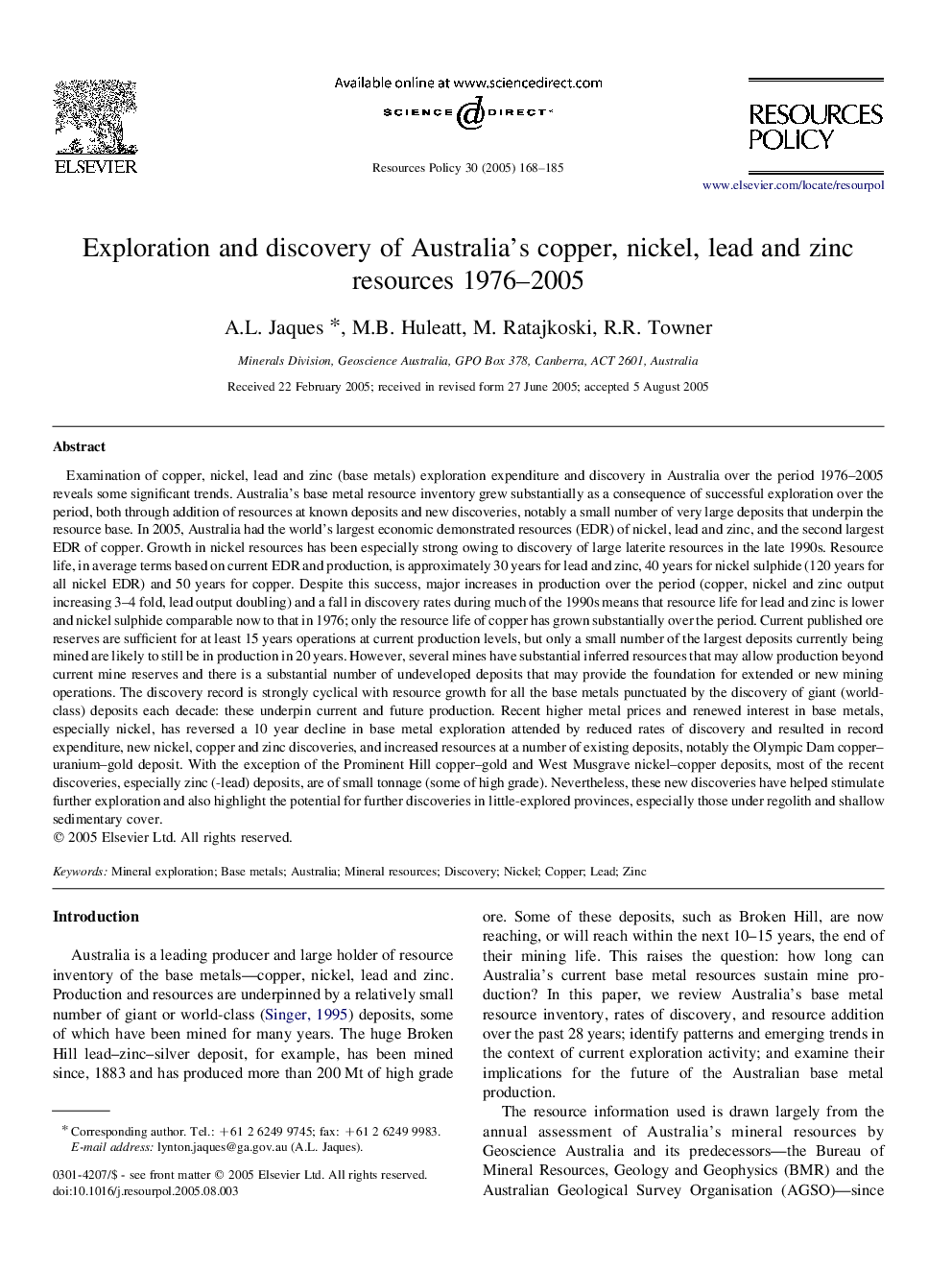| کد مقاله | کد نشریه | سال انتشار | مقاله انگلیسی | نسخه تمام متن |
|---|---|---|---|---|
| 10483886 | 934702 | 2005 | 18 صفحه PDF | دانلود رایگان |
عنوان انگلیسی مقاله ISI
Exploration and discovery of Australia's copper, nickel, lead and zinc resources 1976-2005
دانلود مقاله + سفارش ترجمه
دانلود مقاله ISI انگلیسی
رایگان برای ایرانیان
کلمات کلیدی
موضوعات مرتبط
مهندسی و علوم پایه
علوم زمین و سیارات
زمین شناسی اقتصادی
پیش نمایش صفحه اول مقاله

چکیده انگلیسی
Examination of copper, nickel, lead and zinc (base metals) exploration expenditure and discovery in Australia over the period 1976-2005 reveals some significant trends. Australia's base metal resource inventory grew substantially as a consequence of successful exploration over the period, both through addition of resources at known deposits and new discoveries, notably a small number of very large deposits that underpin the resource base. In 2005, Australia had the world's largest economic demonstrated resources (EDR) of nickel, lead and zinc, and the second largest EDR of copper. Growth in nickel resources has been especially strong owing to discovery of large laterite resources in the late 1990s. Resource life, in average terms based on current EDR and production, is approximately 30 years for lead and zinc, 40 years for nickel sulphide (120 years for all nickel EDR) and 50 years for copper. Despite this success, major increases in production over the period (copper, nickel and zinc output increasing 3-4 fold, lead output doubling) and a fall in discovery rates during much of the 1990s means that resource life for lead and zinc is lower and nickel sulphide comparable now to that in 1976; only the resource life of copper has grown substantially over the period. Current published ore reserves are sufficient for at least 15 years operations at current production levels, but only a small number of the largest deposits currently being mined are likely to still be in production in 20 years. However, several mines have substantial inferred resources that may allow production beyond current mine reserves and there is a substantial number of undeveloped deposits that may provide the foundation for extended or new mining operations. The discovery record is strongly cyclical with resource growth for all the base metals punctuated by the discovery of giant (world-class) deposits each decade: these underpin current and future production. Recent higher metal prices and renewed interest in base metals, especially nickel, has reversed a 10 year decline in base metal exploration attended by reduced rates of discovery and resulted in record expenditure, new nickel, copper and zinc discoveries, and increased resources at a number of existing deposits, notably the Olympic Dam copper-uranium-gold deposit. With the exception of the Prominent Hill copper-gold and West Musgrave nickel-copper deposits, most of the recent discoveries, especially zinc (-lead) deposits, are of small tonnage (some of high grade). Nevertheless, these new discoveries have helped stimulate further exploration and also highlight the potential for further discoveries in little-explored provinces, especially those under regolith and shallow sedimentary cover.
ناشر
Database: Elsevier - ScienceDirect (ساینس دایرکت)
Journal: Resources Policy - Volume 30, Issue 3, September 2005, Pages 168-185
Journal: Resources Policy - Volume 30, Issue 3, September 2005, Pages 168-185
نویسندگان
A.L. Jaques, M.B. Huleatt, M. Ratajkoski, R.R. Towner,